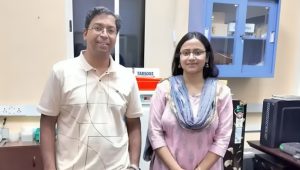A new scientifically useful shape memory alloy (SMA) has been produced by engineers, which springs back into its original shape even after a breathtaking 10 million times’ bending. SMAs are a unique class of metal alloys which are capable of recovering apparent permanent strains after heating over a specified temperature.
The Breakthrough
The new alloy has been created from nickel, titanium and copper, and is several times better than any previous memory alloy as it can sustain 10 million bends before wearing out. Previous alloys had a high-cycle fatigue and could regain their shape once or a few times (the previous highest was 16,000 cycles), but not of this proportion. The alloy has been developed by Prof. Manfred Wuttig of the University of Maryland, USA and his colleagues at the University of Kiel, Germany.
The 10 million times’ bending was achieved by a special crystalisation of the nickel, titanium and copper atoms so they can switch between two different configurations repeatedly. The rebonding can be triggered by either heating or in some cases as soon as the tension is released. The bending is called cycling, and a material may have low-cycle fatigue (LCF) or high-cycle fatigue (HCF). Fatigue is defined as permanent structural change in the material under conditions of fluctuating stress, strains or heat, which may result in crack or complete fracture after a sufficient number of fluctuations. Thus, an HCF material would be able to bear a high number of cycles or bendings before it is fatigued or permanently damaged.
Commercial Use
There are many potential uses of memory alloys, such as creating artificial heart valves, airplane parts such as wing flaps or control surfaces, or unfolding solar panels of a spacecraft, or a new generation of solid-state refrigerators, in addition to usage in surgical operations where a stent may be squashed into a tiny blood vessel and then made to spring back to its original position opening the blocked vessel in the process. In case of refrigerators, instead of using a liquid to compress and expand the compressor, this alloy could be used. Now, the general expectation is that a refrigerator would have a lifecycle of 20 years, so the stressing and recovering millions of times would be possible through this alloy.
The Technological Process
The samples for test were made in tiny square pieces of 1 cm and less than 1 mm thick, and then were checked under both heat and stress. A lot of patience was needed in the ensuing weeks to generate and check the 10 million cycles, though the stress was automatically generated through little stress-strain machines. Testing with temperature was more difficult as a specialised furnace system was used to rapidly heat and cool the samples a full 10 million times and again a few weeks’ patient waiting was done. The changes in the shape and structure were examined using powerful microscopes and through X-rays. It’s an awesome scientific breakthrough as the possibilities of commercial and laboratory usages are ample. Several high-end engineering, medical, space and everyday products would highly benefit.













